|
|
|
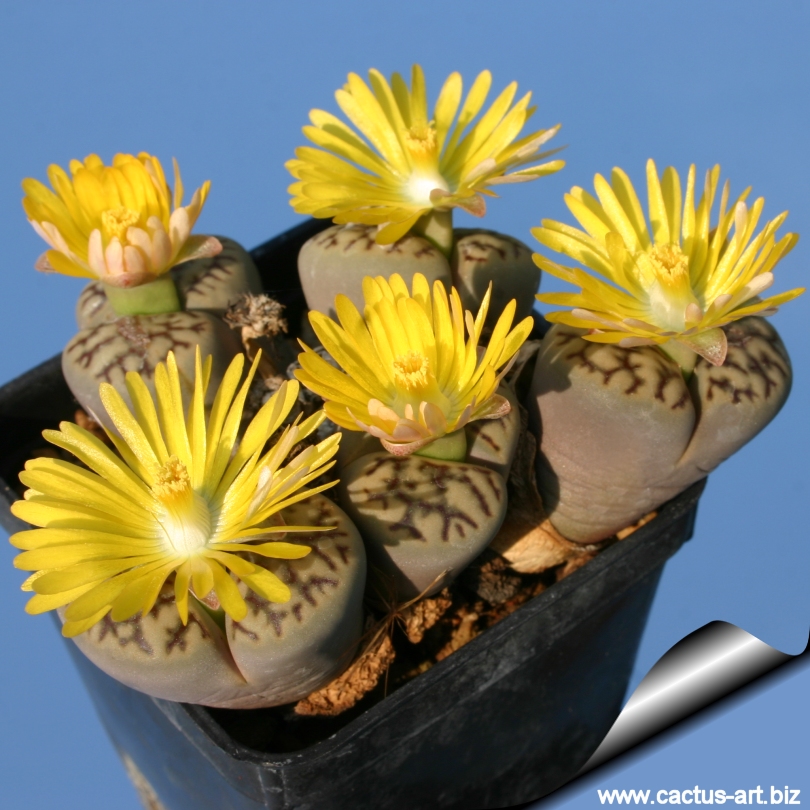
Lithops bromfieldii var. mennelli "Pale selction"
This is a medium sized plant,
readily
clumping.
Distinguished by its rugose surface, pale pinkish-grey facial colour and
very dark rubrications. Yellow flowers in autumn.
|
|
Lithops bromfieldii
comprises several more or less intergrading and distinct variety:
-
Lithops bromfieldii var.
bromfieldii
L. Bolus (1934) Cole numbers: C040, C041, C279, C348,
C368
Medium sized
with a bullate top surface and generally reddish coloured. The face
has impressed valley-like channels and raised islands, sometimes
indistinct and reduced to vague prominences with bold rubrications,
sometimes scattered with dots, hooks and dashes in the channels.
Margins are irregularly incise dentate or sinuate, with peninsulas.
Windows partially closed or accasionally completely open. Shoulders,
margins and islands pale pinkish yellow, deep cream, pale
orange-yellow or pinkish grey, the margins sometimes a little deeper
in colour. Windows and channels various shades of transluscent
brownish or reddish green, greenish red or dull greyish green.
Rubrications bright to dark-blood red, orange-red. Dusky dots dull
dark greyish green.
-
Lithops bromfieldii var.
glaudinae (H.W. de Boer) D.T. Cole (1960) Cole numbers: C116,
C382, C393
Medium sized characterized by many dusky dots with a shining metallic
reflex. The face is opaque, more or less translucent and smooth with
narrow, irregular channels, numerous, small, irregular islands with
indistinct flecks composed of small opaque dots. The margins with
small irregular peninsula are quite indistinct. Rubrications partially
visible, sometimes with longer lines forming a sparse broken network.
Shoulders, margins and islands as for the margins opaque light honey,
pinkish brown or light orange-brown. Windows and channels transluscent
dull green, dark greenish brown or greenish red. Rubrications dull
blood-red.
-
Lithops bromfieldii var. insularis (L. Bol) B. Fearn (1960)
Cole numbers: C042,
C043, C057
Small to medium sized intermediate form between var. bromfieldii and
var. mennellii and often similar to var. glaudinae but without
lustrous dusky dots. Face opaque, transluscent; slightly rugose,
margins indistinct, irregularly dentate with mostly small peninsulas.
Windows usually occluded. Channels broad to narrow, sometimes reduced
to mini-windows; often with lines tailing off into the margins.
Islands fairly small, irregular or reduced to indistinct flecks.
Rubrications often forming a broken network. Shoulders, margins and
islands orange-brown, pinkish, yellowish, greenish or brownish grey or
greyish brown. Windows and channels transluscent greenish red, reddish
green, brown or greenish grey. Rubrications bright to dull blood-red,
purplish red. Dusky dots dull dark greenish grey. as for the margins
or a little lighter.
-
Lithops bromfieldii var.
mennellii (L. Bol) B. Fearn (1937) Cole numbers: C044, C283
Medium sized form with rugose surface, pinkish-grey facial colour and
very dark rubrications .Channels deeply impressed which branch and
tail off into the marginal area and encloding airly large, raised
islands and peninsulas. Margins and windows vaguely distinguishable.
Rubrications filling the channels in anirregular network of lines,
dots, hooks and dashes. Face and shoulders pinkish grey, creamy grey,
greenish grey or light milky grey. Channels dull dark greyish green;
it is often difficult to distinguish between the channels and
concentrations of dusky dots. Rubrications dark red, red-brown or
purplish red. Dusky dots dull dark greyish green.
|
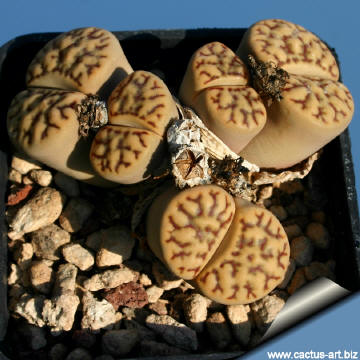 |
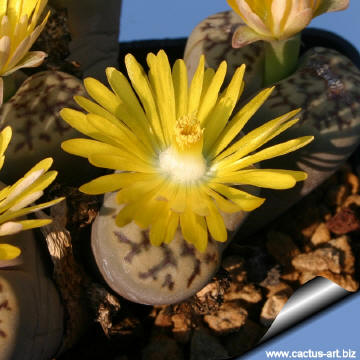 |
|
. |
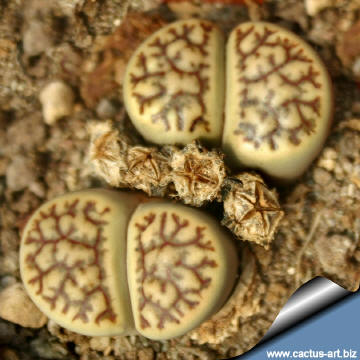 |
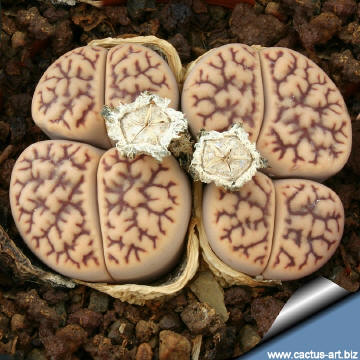 |
|
. |
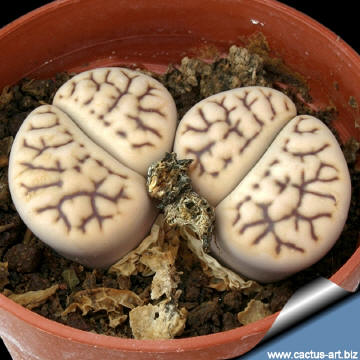 |
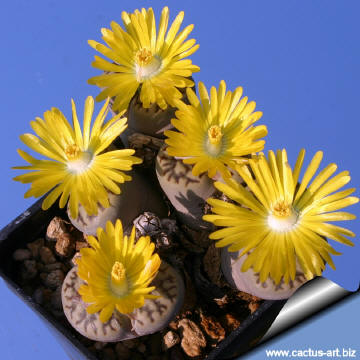 |
|
. |
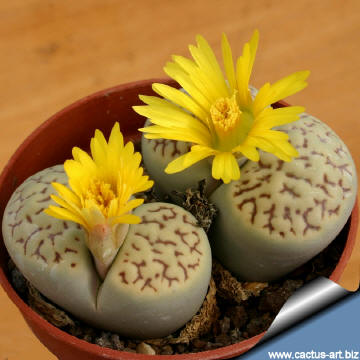 |
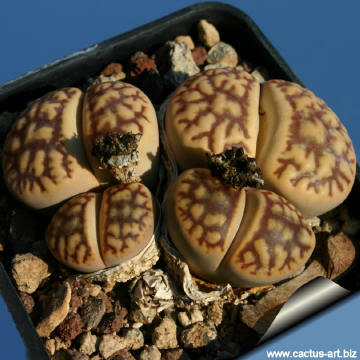 |
|


Advertising
|
|
|
|
|
Family: Mesebrianthemaceae (Aizoaceae)
Scientific name: Lithops bromfieldii var.
mennellii (L. Bol) B. Fearn (1937)
Origin: South Africa, Cape province. It is found in a very
small area on the south side and within 2-3 km of the Orange River, to
the SW of Louisvale, S of Upington. TL 'Louisvale, near Upington, on low
quartz slopes between the road and the Orange River'
Habitat:
Grows in stonily soils comprising
micaceous quartzo-feldspathic
gneiss; granitic gneiss. Colours of the stony background
grey-white, brown, pink.
Common English Names include:
Etymology: Named after Brian T. Mennell who collect
this plant in April 1934.
Synonyms:
- Lithops mennellii
L. Bolus
In: Notes Mesembr. Pt. 3. 75 ., 1937
Common English Names include: Stone plant, Living stone.
Distinguished by its rugose surface, pinkish-grey facial colour and very
dark rubrications.
Description:
Lithops bromfieldii is a medium sized Lithops, mostly
about 25 X 20 mm with up to 10 or more heads, (mostly 2-4)
Body (paired leaves): Obconical, truncate, top surface slightly
convex and bullate generally reddish coloured. The face is elliptical to
kidney-shaped more or less equal with impressed valley-like channels and
raised islands, and bold rubrications. The fissure is shallow, 4-8 mm;
lobes conjunct. This species is characterized by impressed valley-like
channels, raised islands, and bold rubrications and is quite
variable.
Flowers: Yellow, small to large 25-35(-45) mm in diameter. Seeds
yellow-brown, rugose.
This species is quite variable and the colours and
face pattern varies in plant from different provenance.
Cultivars:
-
Lithops bromfieldii var.
bromfieldii cv. 'White Nymph' Japanese cultivar obtained
byYasuhiko Shimada with white flowers, but otherwise indistinguishable
from the type variety.
-
Lithops bromfieldii var.
insularis cv. 'Sulphurea'
Cole number
C362
Japanese
cultivar obtained by Yasuhiko Shimada characterized by a creamy
yellowish-green colour. The Latin name “sulphurea”
means 'sulphur-coloured'. In Japan this form is known as
'Ki-Meigen'.
-
Lithops bromfieldii var.
mennellii "pale selection"
Selected
cultivar from Mesa Garden Nursery characterized by a paler creamy
colour of the island, but otherwise indistinguishable from the
type variety.
|
|
|
|
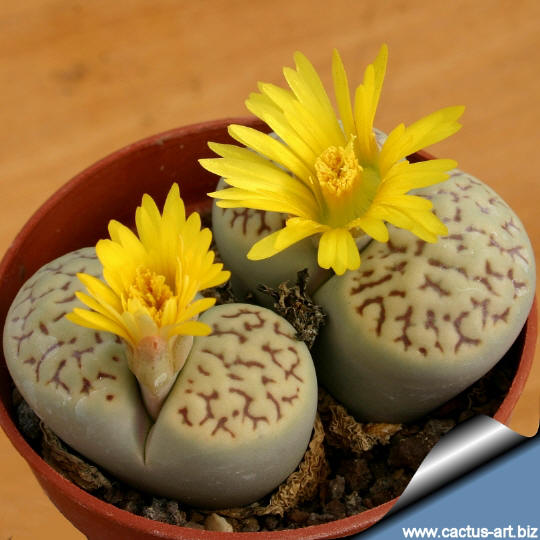
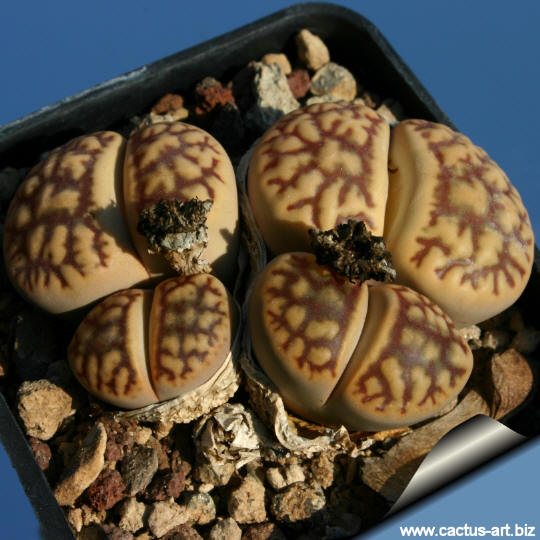
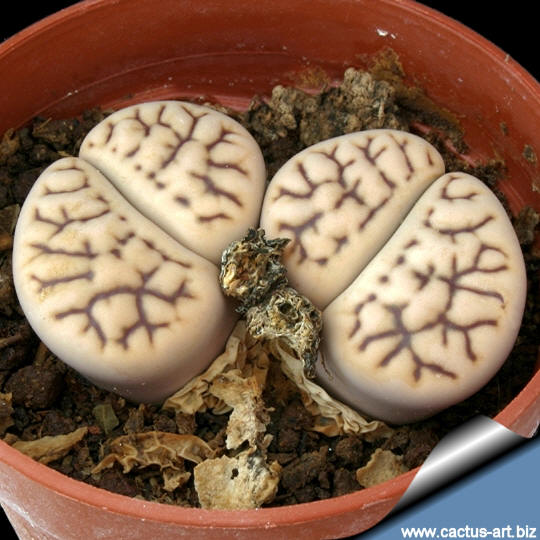
In the
winter season the plant doesn’t need
watering, the
plant in this time extracts
water from the outer
succulent leaves, allowing them
to
shrivel away, relocating water to the rest of the plant and to the
new leaves that form during this period. This plant is best for a well
lit area (Bright shade to
full sun). Water sparingly only when warm, no
water when cold.
This is a beautiful pale
selected
cultivated
form with Grey/brown/orangish top, marked with distinct reddish
or brownish lines and spots (see:
surface pattern) and exhibiting a strong border.
Photo of
conspecific taxa, varieties, forms and cultivars of Lithops
bromfeldii.
|
|